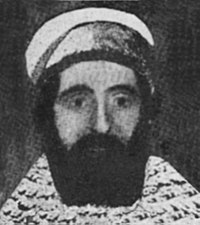| Revision as of 14:13, 13 May 2024 editPeleYoetz (talk | contribs)Extended confirmed users1,225 editsNo edit summaryTag: Visual edit← Previous edit | Revision as of 14:23, 13 May 2024 edit undoPeleYoetz (talk | contribs)Extended confirmed users1,225 edits CopyeditingTag: Visual editNext edit → | ||
| Line 52: | Line 52: | ||
| Regarded as one of the foremost ] (Jewish legal decisors) of his era, Gagin also oversaw the Tiferet Yerushalaim Yeshiva.<ref name=":0" /> Among his notable works is ''Sepher Hatakanoth Vehaskamoth,'' a compendium of Jewish religious rites and customs as practiced in the City of Jerusalem.<ref name="Chaim Abraham Gagin. SepherHatakanothVehaskamoth" /><ref name="Westreich">{{cite journal |last1=Westreich |first1=Elimelech |date=2012 |title=Jewish Judicial Autonomy in Nineteenth Century Jerusalem: Background, Jurisdiction, Structure |journal=Jewish Law Association Studies |volume=22 |page=303 |issn=0890-7552}}</ref> He was also the author of ''Chukei Chaim'', a work addressing the debate on ], and ''Sefer Chaim MiYerushalaim'', a collection of '']''.<ref name=":0" /> | Regarded as one of the foremost ] (Jewish legal decisors) of his era, Gagin also oversaw the Tiferet Yerushalaim Yeshiva.<ref name=":0" /> Among his notable works is ''Sepher Hatakanoth Vehaskamoth,'' a compendium of Jewish religious rites and customs as practiced in the City of Jerusalem.<ref name="Chaim Abraham Gagin. SepherHatakanothVehaskamoth" /><ref name="Westreich">{{cite journal |last1=Westreich |first1=Elimelech |date=2012 |title=Jewish Judicial Autonomy in Nineteenth Century Jerusalem: Background, Jurisdiction, Structure |journal=Jewish Law Association Studies |volume=22 |page=303 |issn=0890-7552}}</ref> He was also the author of ''Chukei Chaim'', a work addressing the debate on ], and ''Sefer Chaim MiYerushalaim'', a collection of '']''.<ref name=":0" /> | ||
| During the 1840s, the ] faced persecution from Muslims who regarded them as "idol worshippers", forcing them to convert to Islam or face execution. The Samaritans asked Gagin to help them, and he wrote a document that the Samaritans are a "a branch of the children of Israel, who acknowledge the truthfulness of the Torah." This proclamation led Muslim authorities to recognize the Samaritans as a Jewish sect, saving them from persecution and extermination.<ref name=":3">{{Cite book |last=שור |first=נתן |title=ספר השומרונים |publisher=יד יצחק בן-צבי; רשות העתיקות; המנהל האזרחי ליהודה ושומרון - קצין מטה לארכאולוגיה |year=2006 |isbn=965-217-202-2 |editor-last=שטרן |editor-first=אפרים |edition=2 |location=ירושלים |pages=604–648 |language=Hebrew |trans-title=Book of the Samaritans |chapter=השומרונים בתקופה הממלוכית, העות'מאנית ובמאה העשרים |trans-chapter=The Samaritans under Mamluk and Ottoman rule and during the 20th century |editor-last2=אשל |editor-first2=חנן}}</ref><ref name=":4">{{Cite book |last=Gafni |first=Reuven |title=The Samaritans |date=2022-01-19 |publisher=Brill |isbn=978-90-04-46691-3 |pages=129–136 |language=en |chapter=Two Minorities on the Brink: Jews and Samaritans in Nineteenth-Century Nablus |doi=10.1163/9789004466913_014 |chapter-url=https://brill.com/display/book/edcoll/9789004466913/BP000014.xml}}</ref><ref>], "The Book of the Samaritans", 19353 Pp.36.</ref> | |||
| In the years 1831-1840, the muslims in the Land of Israel were persecuting the Samaritans to either convert to islam or die, claiming that the Samaritans due to not being either Jewish or Christians were "idol worshippers" and therefore must be killed. The Samaritans asked Gagin to help them, and he wrote a document that the Samaritans are a "Jewish sect" to save them from extermination after many of them were forced to convert to islam.<ref>], "The Book of the Samaritans", 19353 Pp.36.</ref> | |||
| Gagin was interred on the ].<ref name=":0" /> | Gagin was interred on the ].<ref name=":0" /> | ||
Revision as of 14:23, 13 May 2024
| Chaim Abraham Gagin | |
|---|---|
 image attributed to Chaim Abraham Gaguine image attributed to Chaim Abraham Gaguine | |
| Personal life | |
| Born | 1787 Constantinople, Ottoman Empire |
| Died | 23 May 1848(1848-05-23) (aged 60–61) Jerusalem, Ottoman Empire |
| Religious life | |
| Religion | Judaism |
| Jewish leader | |
| Predecessor | Yehuda Navon |
| Successor | Yitzhak Kovo |
Chaim Abraham Gagin (1787–1848) was Chief Rabbi of Ottoman Palestine from 1842 to 1848.
Born in Constantinople, he was the grandson of the Jerusalem Kabbalist Shalom Sharabi. Gagin was the first individual to hold both the positions of Hakham Bashi and Rishon Lezion simultaneously following their merger.
Regarded as one of the foremost poskim (Jewish legal decisors) of his era, Gagin also oversaw the Tiferet Yerushalaim Yeshiva. Among his notable works is Sepher Hatakanoth Vehaskamoth, a compendium of Jewish religious rites and customs as practiced in the City of Jerusalem. He was also the author of Chukei Chaim, a work addressing the debate on halukka, and Sefer Chaim MiYerushalaim, a collection of derashot.
During the 1840s, the Samaritans faced persecution from Muslims who regarded them as "idol worshippers", forcing them to convert to Islam or face execution. The Samaritans asked Gagin to help them, and he wrote a document that the Samaritans are a "a branch of the children of Israel, who acknowledge the truthfulness of the Torah." This proclamation led Muslim authorities to recognize the Samaritans as a Jewish sect, saving them from persecution and extermination.
Gagin was interred on the Mount of Olives.
References
- ^ ברטל, ישראל. "הארץ ויהודיה". In בן-נאה, ירון; הלד דילהרוזה, מיכל (eds.). הישוב הישן הספרדי בארץ ישראל (in Hebrew). מכון בן-צבי לחקר קהילות ישראל במזרח של יד בן-צבי והאוניברסיטה העברית. p. 15. ISSN 1565-0774.
- ^ "Chaim Abraham Gagin. Sepher Hatakanoth Vehaskamoth". Kestenbaum & Co. Archived from the original on 4 March 2016. Retrieved 9 August 2015.
- Westreich, Elimelech (2012). "Jewish Judicial Autonomy in Nineteenth Century Jerusalem: Background, Jurisdiction, Structure". Jewish Law Association Studies. 22: 303. ISSN 0890-7552.
- שור, נתן (2006). "השומרונים בתקופה הממלוכית, העות'מאנית ובמאה העשרים" [The Samaritans under Mamluk and Ottoman rule and during the 20th century]. In שטרן, אפרים; אשל, חנן (eds.). ספר השומרונים [Book of the Samaritans] (in Hebrew) (2 ed.). ירושלים: יד יצחק בן-צבי; רשות העתיקות; המנהל האזרחי ליהודה ושומרון - קצין מטה לארכאולוגיה. pp. 604–648. ISBN 965-217-202-2.
- Gafni, Reuven (2022-01-19). "Two Minorities on the Brink: Jews and Samaritans in Nineteenth-Century Nablus". The Samaritans. Brill. pp. 129–136. doi:10.1163/9789004466913_014. ISBN 978-90-04-46691-3.
- Isaac Ben-Zvi, "The Book of the Samaritans", 19353 Pp.36.
| Heads of Beit El Kabbalist yeshiva | |
|---|---|
|